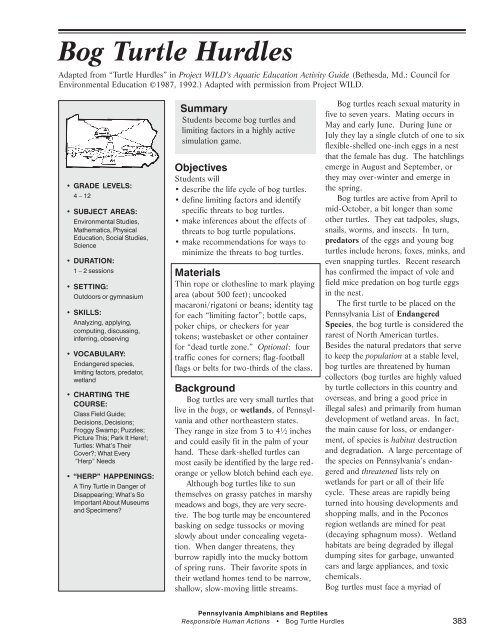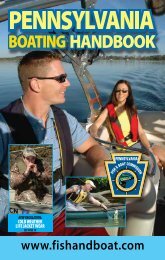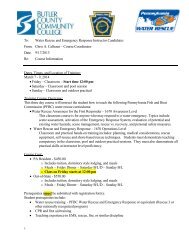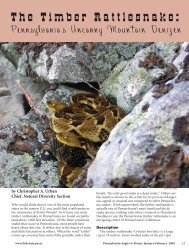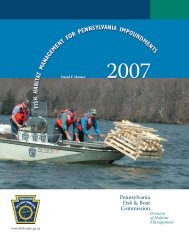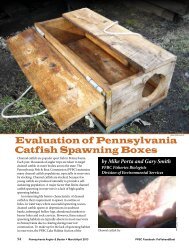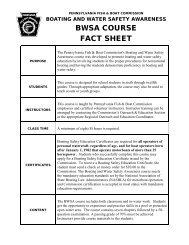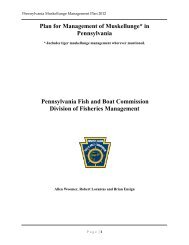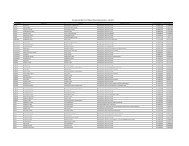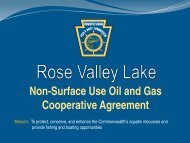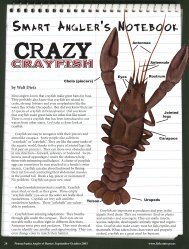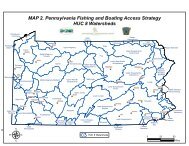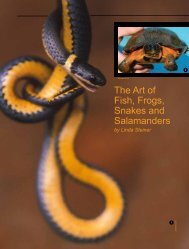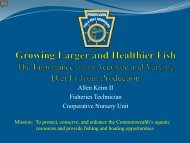Pennsylvania Amphibian And Reptiles : A Curriculum Guide Sampler
Pennsylvania Amphibian And Reptiles : A Curriculum Guide Sampler
Pennsylvania Amphibian And Reptiles : A Curriculum Guide Sampler
You also want an ePaper? Increase the reach of your titles
YUMPU automatically turns print PDFs into web optimized ePapers that Google loves.
Bog Turtle Hurdles<br />
Adapted from “Turtle Hurdles” in Project WILD’s Aquatic Education Activity <strong>Guide</strong> (Bethesda, Md.: Council for<br />
Environmental Education ©1987, 1992.) Adapted with permission from Project WILD.<br />
GRADE LEVELS:<br />
4 – 12<br />
SUBJECT AREAS:<br />
Environmental Studies,<br />
Mathematics, Physical<br />
Education, Social Studies,<br />
Science<br />
DURATION:<br />
1 – 2 sessions<br />
SETTING:<br />
Outdoors or gymnasium<br />
SKILLS:<br />
Analyzing, applying,<br />
computing, discussing,<br />
inferring, observing<br />
VOCABULARY:<br />
Endangered species,<br />
limiting factors, predator,<br />
wetland<br />
CHARTING THE<br />
COURSE:<br />
Class Field <strong>Guide</strong>;<br />
Decisions, Decisions;<br />
Froggy Swamp; Puzzles;<br />
Picture This; Park It Here!;<br />
Turtles: What’s Their<br />
Cover?; What Every<br />
“Herp” Needs<br />
“HERP” HAPPENINGS:<br />
A Tiny Turtle in Danger of<br />
Disappearing; What’s So<br />
Important About Museums<br />
and Specimens?<br />
Summary<br />
Students become bog turtles and<br />
limiting factors in a highly active<br />
simulation game.<br />
Objectives<br />
Students will<br />
describe the life cycle of bog turtles.<br />
define limiting factors and identify<br />
specific threats to bog turtles.<br />
make inferences about the effects of<br />
threats to bog turtle populations.<br />
make recommendations for ways to<br />
minimize the threats to bog turtles.<br />
Materials<br />
Thin rope or clothesline to mark playing<br />
area (about 500 feet); uncooked<br />
macaroni/rigatoni or beans; identity tag<br />
for each “limiting factor”; bottle caps,<br />
poker chips, or checkers for year<br />
tokens; wastebasket or other container<br />
for “dead turtle zone.” Optional: four<br />
traffic cones for corners; flag-football<br />
flags or belts for two-thirds of the class.<br />
Background<br />
Bog turtles are very small turtles that<br />
live in the bogs, or wetlands, of <strong>Pennsylvania</strong><br />
and other northeastern states.<br />
They range in size from 3 to 4½ inches<br />
and could easily fit in the palm of your<br />
hand. These dark-shelled turtles can<br />
most easily be identified by the large redorange<br />
or yellow blotch behind each eye.<br />
Although bog turtles like to sun<br />
themselves on grassy patches in marshy<br />
meadows and bogs, they are very secretive.<br />
The bog turtle may be encountered<br />
basking on sedge tussocks or moving<br />
slowly about under concealing vegetation.<br />
When danger threatens, they<br />
burrow rapidly into the mucky bottom<br />
of spring runs. Their favorite spots in<br />
their wetland homes tend to be narrow,<br />
shallow, slow-moving little streams.<br />
Bog turtles reach sexual maturity in<br />
five to seven years. Mating occurs in<br />
May and early June. During June or<br />
July they lay a single clutch of one to six<br />
flexible-shelled one-inch eggs in a nest<br />
that the female has dug. The hatchlings<br />
emerge in August and September, or<br />
they may over-winter and emerge in<br />
the spring.<br />
Bog turtles are active from April to<br />
mid-October, a bit longer than some<br />
other turtles. They eat tadpoles, slugs,<br />
snails, worms, and insects. In turn,<br />
predators of the eggs and young bog<br />
turtles include herons, foxes, minks, and<br />
even snapping turtles. Recent research<br />
has confirmed the impact of vole and<br />
field mice predation on bog turtle eggs<br />
in the nest.<br />
The first turtle to be placed on the<br />
<strong>Pennsylvania</strong> List of Endangered<br />
Species, the bog turtle is considered the<br />
rarest of North American turtles.<br />
Besides the natural predators that serve<br />
to keep the population at a stable level,<br />
bog turtles are threatened by human<br />
collectors (bog turtles are highly valued<br />
by turtle collectors in this country and<br />
overseas, and bring a good price in<br />
illegal sales) and primarily from human<br />
development of wetland areas. In fact,<br />
the main cause for loss, or endangerment,<br />
of species is habitat destruction<br />
and degradation. A large percentage of<br />
the species on <strong>Pennsylvania</strong>’s endangered<br />
and threatened lists rely on<br />
wetlands for part or all of their life<br />
cycle. These areas are rapidly being<br />
turned into housing developments and<br />
shopping malls, and in the Poconos<br />
region wetlands are mined for peat<br />
(decaying sphagnum moss). Wetland<br />
habitats are being degraded by illegal<br />
dumping sites for garbage, unwanted<br />
cars and large appliances, and toxic<br />
chemicals.<br />
Bog turtles must face a myriad of<br />
<strong>Pennsylvania</strong> <strong>Amphibian</strong>s and <strong>Reptiles</strong><br />
Responsible Human Actions Bog Turtle Hurdles 383


